What is Optimism? Optimism is a set of solutions created with the goal of solving outstanding problems on Ethereum regarding expensive transaction fees and slow transaction speeds. So, if there’s anything interesting about Optimism, let’s find out together in the article below.
To understand more about Optimism, people can read some of the articles below:
- What is Layer 2? Complete Guide to Layer 2 Solutions
- What is Arbitrum (ARB)? Arbitrum Cryptocurrency Overview
Overview of Optimism
What is Optimism?
Optimism is a Layer 2 platform on Ethereum using Optimistic Rollup technology built by the Optimism Foundation. Optimism solves the scalability problem by sending transactions off-chain to execute and then send them to Ethereum for consensus and storage, thereby solving the scalability problem while still being inherited. Decentralization and security from Ethereum.
As a Layer 2 platform using Optimistic Rollup technology, Optimism has features including:
- Ability of extension: Transaction speed and transaction fees on Optimism are 10 – 100 times faster than on Ethereum.
- Enjoy confidentiality: As a Layer 2 of Ethereum, Optimism enjoys the security and decentralization of Ethereum.
- EVM: Optimism has a high level of compatibility with EVM, helping developers on Ethereum or EVM Blockchain to easily move and develop their products on Optimism.
- Product diversity: Not only is it a regular Optimistic Rollup Chain, Optimism Foudation also built an SDK called OP Stack so that many projects can independently build Layer 2 based on Optimism’s open source code.
Optimistic Rollup’s technology is much easier to deploy than ZK Rollup, so Optimism has officially mainneted the network since the end of 2021 and has certain leading advantages compared to later ZK Rollup platforms, although in terms of technology Technology is underrated. However, with its Superchain product, Optimism has aimed to use Zero-knowledge technology in the future.
Optimism’s mechanism of action
To operate Optimism, it is necessary to have the participation of many different roles, including:
- Sequencer: Plays the role of executing and arranging transactions on Optimism into 1 Batch (lot). Each batch can be less than hundreds or even thousands of transactions that are then posted to Ethereum. Sequencer is very different from Validator.
- Proposer: Plays the role of updating the network state (State Root) to Ethereum.
- Challenger: Anyone can observe the operation process of Optimism and provide evidence of fraud (Fraud Proof) when detecting malicious transactions.
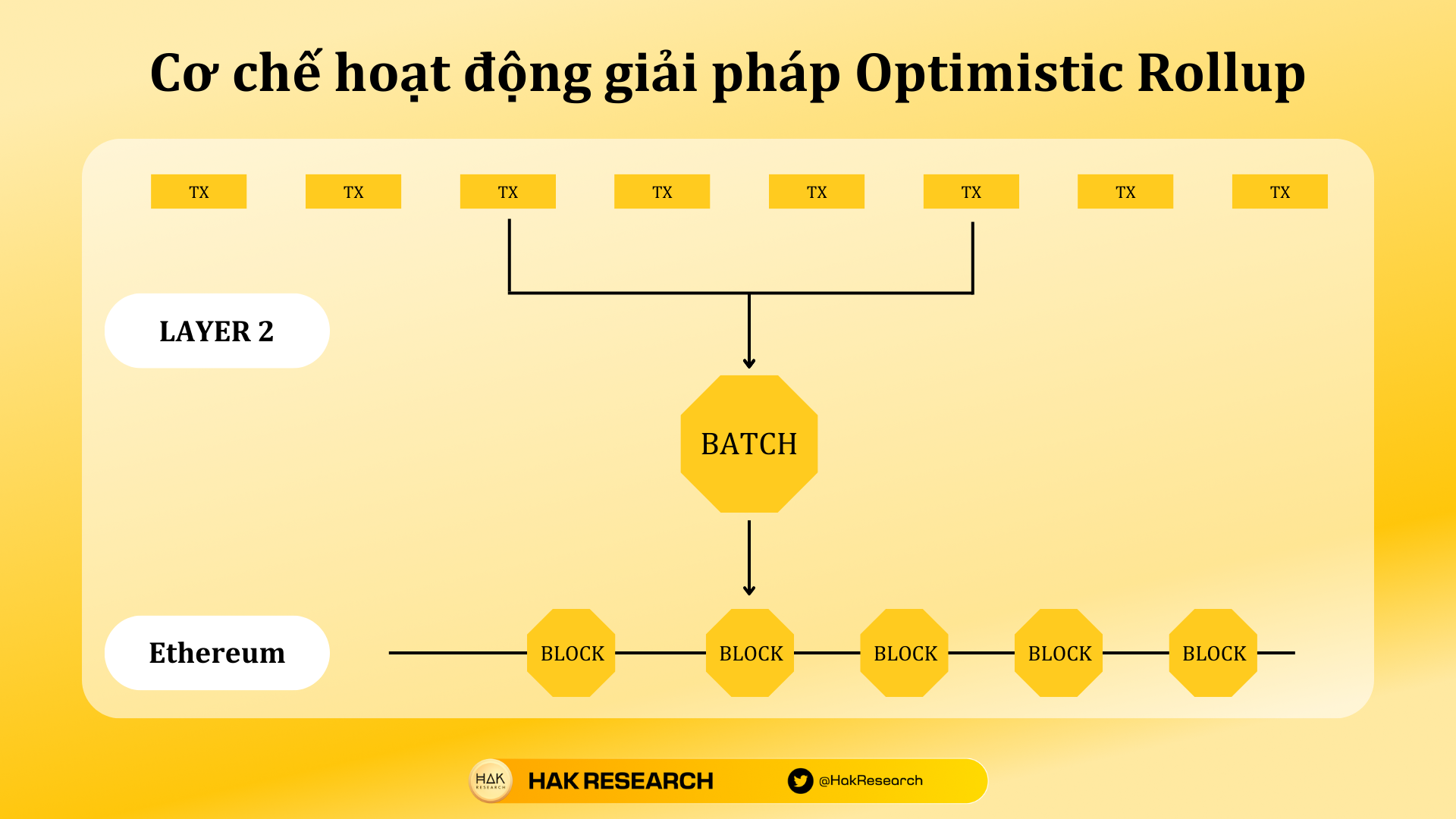
The operating mechanism of Optimism will basically take place as follows:
- Step 1: Squencer is responsible for arranging transactions on Arbitrum for a certain period of time into 1 Batch in addition to verifying the correctness of the transaction.
- Step 2: After successfully packaging the transaction into a Batch, this Batch will be sent to Ethereum. Along with Sequencer uploading Batch to Ethereum, Proposer also updates State Root to Ethereum. Batch posting and State Root update do not need to be done together.
- Step 3: In Ethereum, State Root will have a 7-day challenge period. If within 7 days anyone submits a Fraud Proof proving that there are malicious transactions in State Root, dispute resolution mode will be activated. If within 7 days there are no accusations, then State Root is considered successful.
- Step 4: Successful verification of State Root will be updated on Ethereum main chain and the transaction cannot be reversed.
It can be seen that within 7 days, even transactions that have been successfully executed on the Layer 2 network can be completely reversed. This challenging period is also the reason why withdrawing money from the Optimistic Rollup platforms to Ethereum will take about 7 days.
Total Ecology of Optimism
Up to now, Optimism’s ecosystem can be divided into two types: Optimism ecosystem and Superchain ecosystem.
Overview of the Optimism ecosystem
Optimism and Arbitrum have become one of the two largest Layer 2 ecosystems on the market today, including a variety of different pieces such as:
- DEX: Velodrome, Uniswap, Curve Finance, Beethoven X, KyberSwap, 1inch, SushiSwap,…
- Lending & Borrowing: AAVE, Sonne Finance, QiDAO, dForce,…
- Derivatives: Synthetix, Perpetual, Lyra, Kwenta, Pika Protocol, Mummy Finance, Premia,…
- Yield Farming: Beefy, Arrakis Finance, Reaper Farm, Pickle Finance,…
- NFT & Gaming: Backed, BlueSweep, Bored Town, Aethernity, Apetimism, Dope Wars, Dragonia, Mintplex, Gladiaxy, Ganland, Geo Web,…
- Bridge: Stargate, Hop Protocol, Synapse Protocol, Across, Beamer, Biconomy Hyphen, Bungee Finance, Celer Network, Celer Network, Li Fi Finance, LayerSwap,…
- Wallets: Rainbow, Coin98 Wallet, Bridge Wallet, Fox Wallet, Cwallet, Taho, Coinbase Wallet, Metamask, Rainbow,…
- Some other pieces: dHEGDE, Pool Together, Gamma Strategicts,…
It can be said that Optimism’s ecosystem is developing relatively strongly compared to the general level of the Layer 1 and Layer 2 market at the present time.
Overview of the SuperChain ecosystem
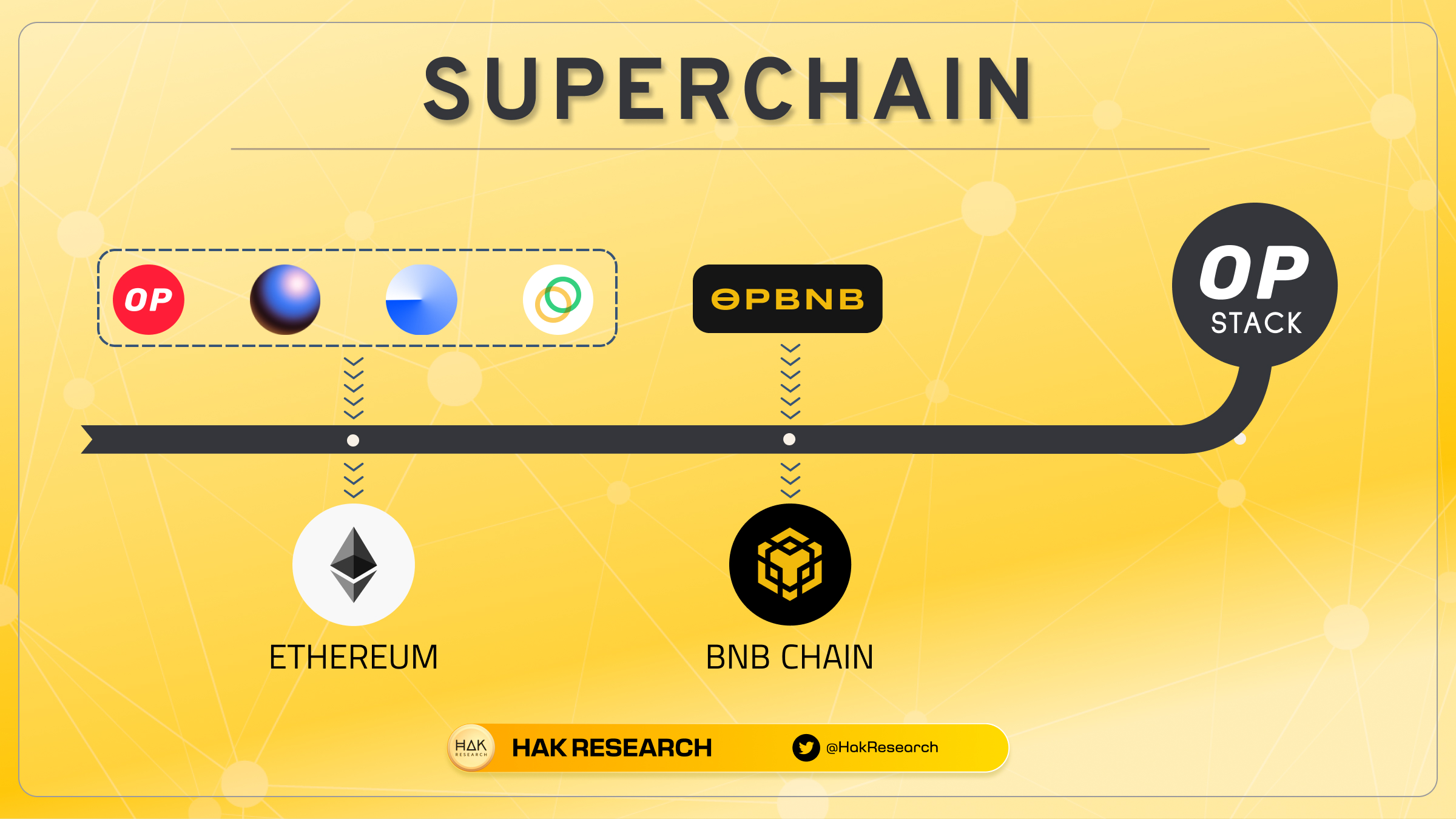
SuperChain are projects that use the Optimism SDK Framework called OP Stack to build their own Layer 2 platform. When it first launched, there were a number of typical projects built on OP Stack such as Base – built by Coinbase. Not only stopping at Base, Superchain’s ecosystem also receives a lot of participation such as:
- April 20, 2023: A16Z announced the construction of Magi as a Rollup Client on Superchain.
- June 22, 2023: NFT Marketplace Zora project also decided to move to Layer 2 through Optimism’s OP Stack.
- June 28, 2023: Binance also decided to build an Optimistic Rollup on OP Stack.
- July 17, 2022: Celo – a Layer 1 platform for Mobile has decided to become a Layer 2 based on OP Stack technology.
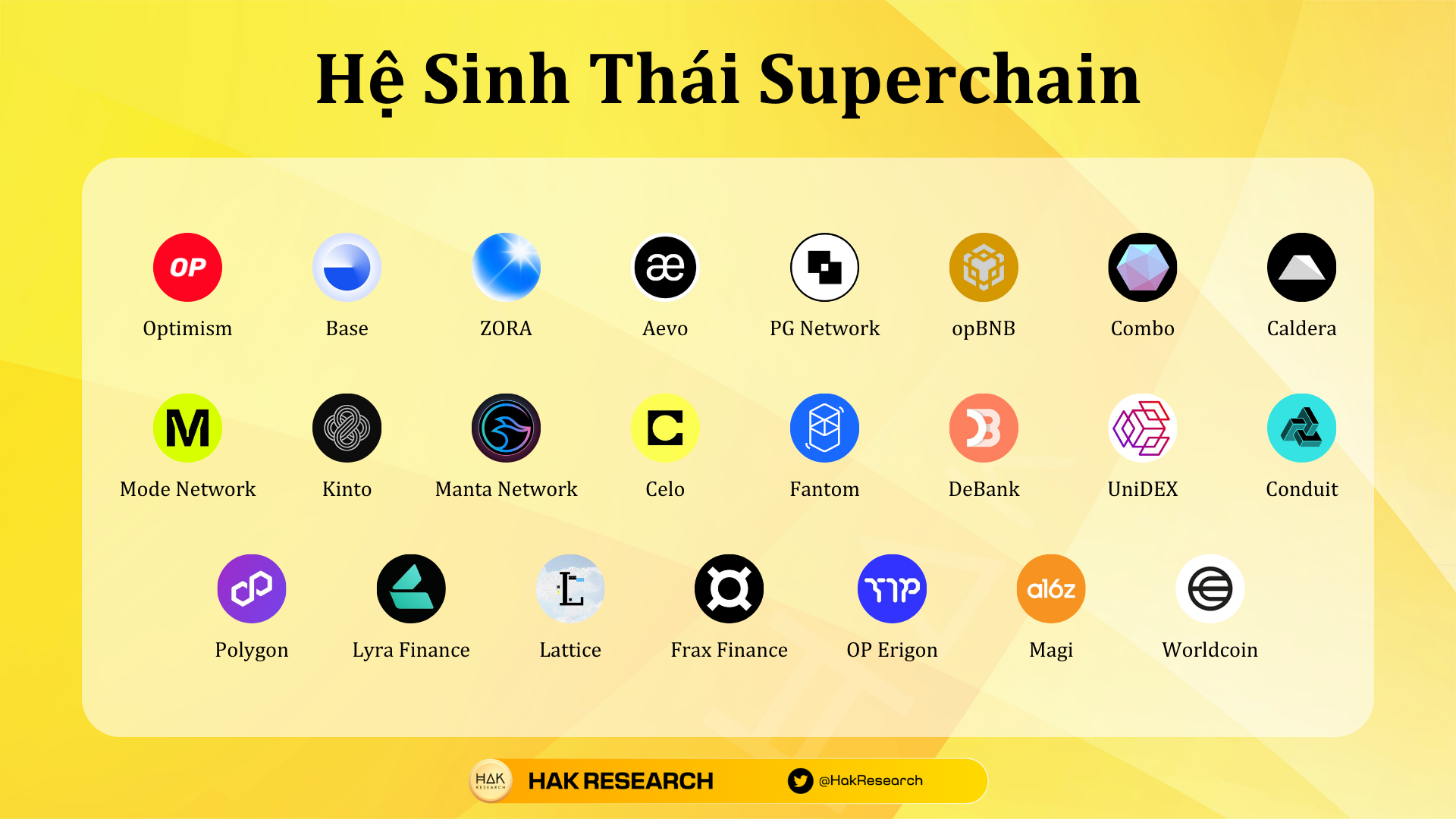
The Superchain ecosystem is expanding over time with many different projects participating in becoming a Layer 2 through OP Stack technology including:
- Layer 1: Polygon, Celo, Fantom, Manta Neywork,…
- DApp: Lyra Finance, DeBank, Frax Finance, Aevo, ZORA,…
- CeFi: Binance, Coinbase, A16Z,…
Development Roadmap
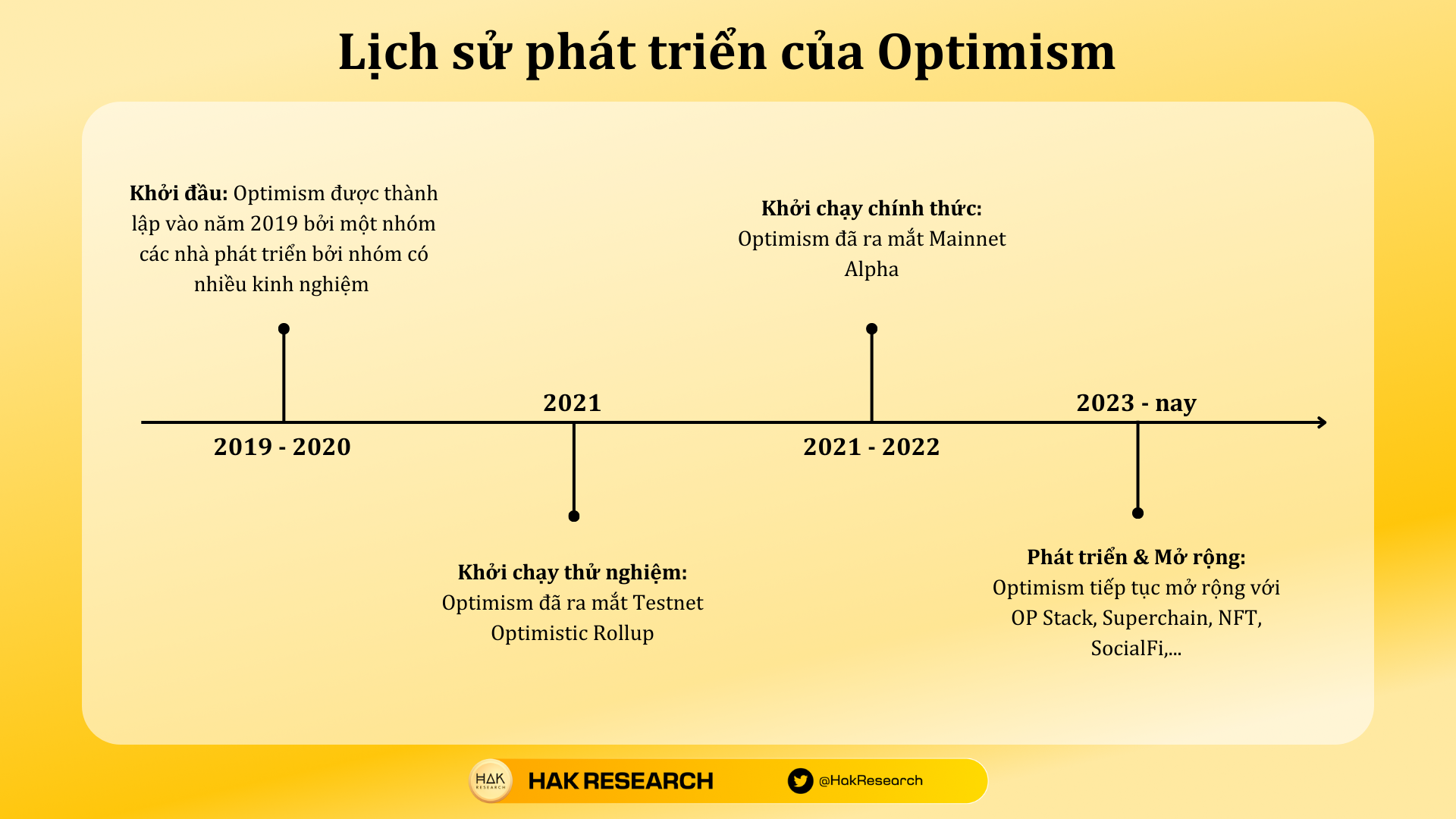
In the near future, Optimism Foundation will focus on building two main products, which are also their strategic products, including:
- July 19, 2022: Optimism introduces its new proof of transaction CANON after removing the old proof of transaction that did not work well. CANON can have a profound impact on Optimism in particular and the Superchain ecosystem in general in the near future. At the time of introduction, CANON was still being built and developed by the team.
- October 18, 2022: Optimism development team introduces OP Stack to help developers easily build their own Layer 2 with high customization as projects can choose layers such as Execution, Settlement or Consensus. This laid the foundation for Superchain shortly thereafter.
- August 4, 2023: Optimism successfully upgraded the Bedrock update with improved network scalability for faster and cheaper transactions. There are also many more updates that have a big impact on developers as building projects becomes faster, cheaper and easier.
Investor
The total amount of money that Optimism has called since its inception is up to nearly $200M with a small number of VCs participating, including:
- January 15, 2020: Optimism successfully called for the first Seed round for $3.5M with the participation of Paradigm and IDEO CoLab Ventures.
- February 24, 2021: After more than 1 year, Optimism successfully raised $25M in Series A round with the participation of A16Z and Nascent.
- March 17, 2022: The last time Optimism successfully called for an amount of up to $150M with the leadership of Paradigm and A16Z and the participation of Nascent.
- September 21, 2022: Optmism sold 116M OP in Treasury at a price of $163M to 7 different undisclosed investment funds.
Core Team
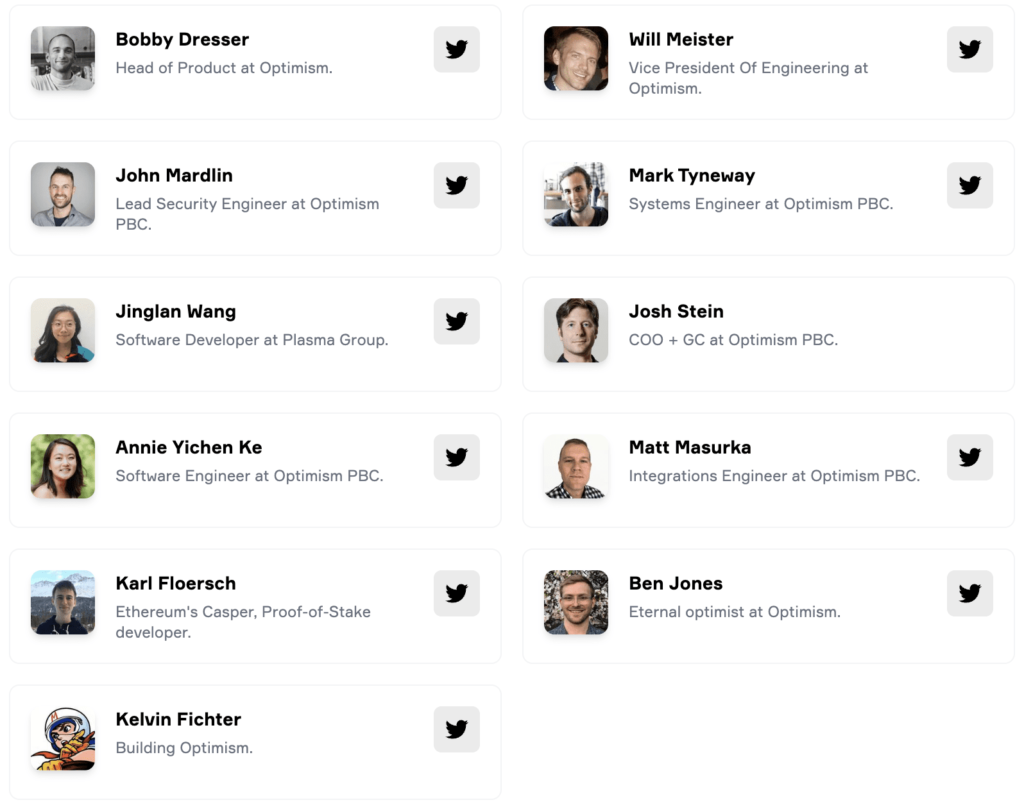
Following Optimism is Optimism Foundation, it will develop, research, test, and develop the ecosystem in the initial period. When enough time passes and the system generates enough gold, the Optimism Foundation will disband and hand over development work to the entire community.
Jinglan Wang: Co Founder & CEO
- Jinglan studied Art and Computer Science at Wellesley College, but eventually dropped out and founded his own company called Eximchain.
- After the successful Eximchain ICO, Jinglan left his company and worked at NASDAQ as a product manager for their Blockchain projects, as Jinglan was a member of the IDEO blockchain fellowship, sponsored by NASDAQ .
- Jinglan Wang started participating in Plasma, which is now Optimism by taking the Cryptoeconomics.Study course and getting interested in the Plasma solution. In 2018, Jinglan Wang co-founded Optimism.
Ben Jones: Co Founder & Director
- Ben earned his bachelor’s degree in Science, Physics and Mathematics from Northeastern University.
- Ben worked as a Software Engineer at Quantum Diamond Technologies IncQuantum for a relatively short period of time.
- After that, Ben joined the Crypto market as Blockchain Associate at Underscore VC.
- Ben started his business with Plasma Group and then from December 2019, Ben started building and developing at Optimism PBC with the title of Co Founder and Scientific Director.
- In May 2022, Ben moved from Optimism PBC to become Director at Optimism Foundation.
Karl Floersch: CEO of OP Labs
- Karl earned his bachelor’s degree in Science, Computer Science from Stony Brook University.
- Karl used to work as a Frontend Engineer at 3Rings Media3Rings and a Blockchain Engineer at Consensys – the parent company of Metamask or Infura.
- Karl has had a long time working with the Ethereum Foundation with the title of Research for 2 years and 5 months.
- From January 2020, Karl began to be in charge of CTO at OP Labs and then CEO from May 2023.
Besides, Optimism is also built by a number of members such as:
- Eva Beylin is Director of the Graph Foundation
- Abbey Titcomb is currently the Radicle community development team
- Brian Avello is from the Maker Foundation
Tokenomics
Overview information about the Optimism token
- Token name: Optimism
- Code: OP
- Blockchain: Optimism
- Token classification: ERC 20
- Contract: 0x42000000000000000000000000000000000042
- Total supply: 4,294,967,296
Token Allocation
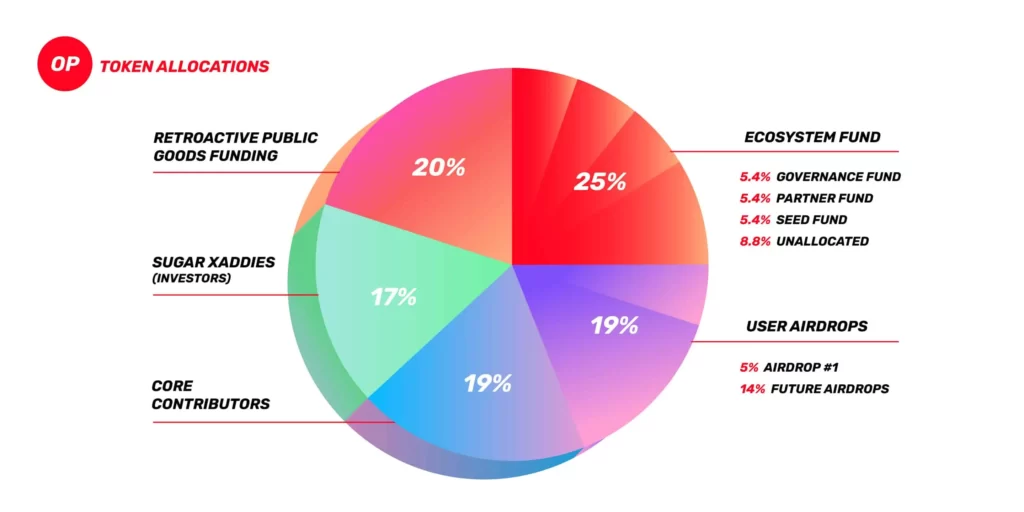
- Ecosystem Fund: 25%
- User Airdrop: 19%
- Core Contributors: 19%
- Sugar Xaddies: 17%
- Retroactive Public Goods Funding: 20%
Token Release
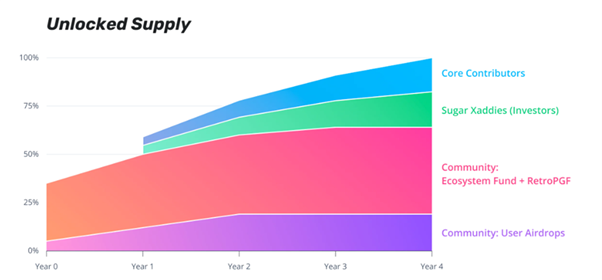
All project tokens will be paid in installments over 4 years with the core team and investors (A16Z, Paradigm, Nascent) locked for 1 year then paid in installments over the remaining 3 years.
Token Use Case
Recently, Optimism introduced a decentralized autonomous organization DAO, Optimism Collective, which will be built to promote the development of Optimism in all aspects such as ecosystem, promotion, and marketing. In the long term, together with the Optimism Foundation, the Optimism Collective will jointly manage the development of Optimism in a comprehensive way.
Optimism Collective is managed by two parts: Citizen’s House and Token House.
- Token House : Established when the first airdrop reached users to pay tribute to individuals whose contributions promoted the development of Optimism.
- Citizen’s House : Established with the goal of determining the amount of incentives for projects and activities that are beneficial to the ecological system. Individuals here will receive NFTs that cannot be converted into soundbond tokens that will be revealed more in the future.
It can be said that Optimism is creating a game with the most use cases with individuals holding OP tokens
Exchanges
You can trade Optimism (OP) tokens at several exchanges such as: Binance, MEXC, OKX, Coinbase, BingX, Houbi, …
Optimism’s Information Channels
- Twitter: https://twitter.com/optimismFND
- Website: https://www.optimism.io/
- Discord:
summary
Optimism has had its first major airdrop in the community, but the project still has many airdrops ahead so you can comfortably experience in-game skins with this ecosystem.


